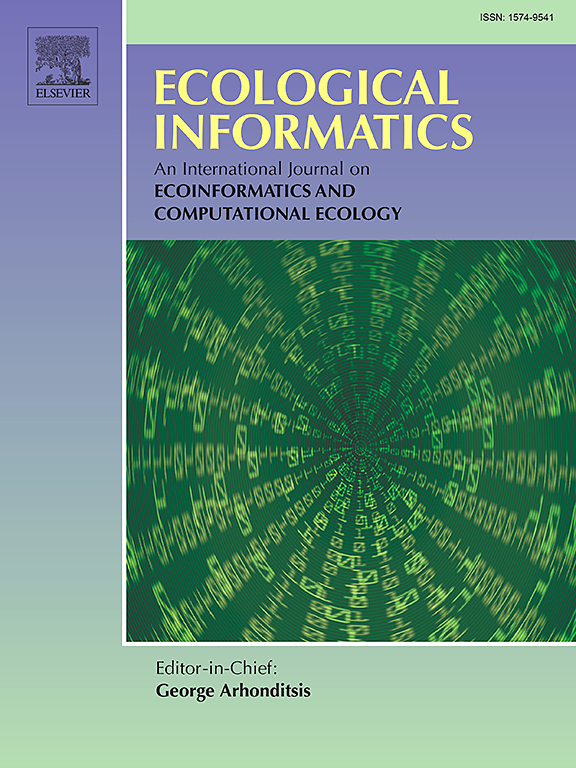结合高空间分辨率多光谱遥感数据和野外观测分析大型哺乳食草动物对东非稀树草原植被结构的影响
IF 5.8
2区 环境科学与生态学
Q1 ECOLOGY
引用次数: 0
摘要
众所周知,非洲热带稀树草原生态系统中的放牧和浏览调节了树草比。然而,由于土地利用和气候变化,许多大型哺乳动物正面临压力。预测它们的丰度变化或范围变化将如何与稀树草原结构相互作用是具有挑战性的。草食动物排除实验有助于更好地了解不同大小的草食动物对植被结构和组成的影响,包括与降雨的相互作用。本文结合降雨不确定性下有蹄类草食(UHURU)排除实验的野外数据和PlanetScope和Sentinel-2系列高空间分辨率卫星图像,研究了草食动物对肯尼亚热带稀树草原植被结构的影响。野外数据以及Sentinel-2的NDVI值和PlanetScope的NDVI对比值表明,草食动物的存在降低了植被覆盖,并根据草食动物的存在改变了木本植被的结构。当大型食草动物不存在而中小型食草动物存在时,植被生长最高,NDVI对比值较高。草食动物的缺失导致裸地斑块减少,绿色生物量增加,如平均冠层宽度增大,从而导致NDVI值增大。很少有研究探索被动遥感数据在样地尺度以外较长时间内评估草食影响的潜力;然而,这些先前的研究只关注NDVI。在这里,我们展示了利用GLCM纹理测量来研究草食动物存在或不存在对稀树草原生态系统的影响的附加价值。将这些数据与地块测量相结合,我们的研究证明了在生态系统研究中结合野外和空间视角的好处。本文章由计算机程序翻译,如有差异,请以英文原文为准。
Analysing the impact of large mammal herbivores on vegetation structure in Eastern African savannas combining high spatial resolution multispectral remote sensing data and field observations
It is well understood, that grazing and browsing in the African savanna ecosystem modulates tree-grass ratios. However, many of the large mammals are under pressure due to land use and climate change. It is challenging to predict how their altered abundance or range shifts will interact with savanna structure. Herbivore exclusion experiments can help to better understand the impacts of herbivores of different sizes on vegetation structure and composition, including interactions with rainfall. Here, we combine field data of the Ungulate Herbivory Under Rainfall Uncertainty (UHURU) exclusion experiment and high spatial resolution satellite images of the PlanetScope and Sentinel-2 series to investigate the impacts of herbivores on vegetation structure in a Kenyan savanna. Field data as well as NDVI values derived from Sentinel-2 and NDVI contrast values of PlanetScope show that presence of herbivores lowers vegetation cover and modify the woody vegetation structure depending on which herbivores are present. The vegetation grew tallest when mega-sized herbivores were absent but meso-sized and small herbivores were present, which resulted in high NDVI contrast values. The absence of herbivores resulted in fewer bare ground patches and increased green biomass, such as a higher mean canopy width, which led to higher NDVI values. Few studies have explored the potential of passive remote sensing data to assess herbivory impacts beyond the plot scale and over longer time-periods; however, these previous studies solely focused on the NDVI. Here we demonstrate the added value of also using GLCM texture measures to investigate effects on a savanna ecosystem in response to presence or absence of herbivores. Combining these data with plot measurements our study demonstrates the benefits of combining field and space perspectives in ecosystem studies.
求助全文
通过发布文献求助,成功后即可免费获取论文全文。
去求助
来源期刊

Ecological Informatics
环境科学-生态学
CiteScore
8.30
自引率
11.80%
发文量
346
审稿时长
46 days
期刊介绍:
The journal Ecological Informatics is devoted to the publication of high quality, peer-reviewed articles on all aspects of computational ecology, data science and biogeography. The scope of the journal takes into account the data-intensive nature of ecology, the growing capacity of information technology to access, harness and leverage complex data as well as the critical need for informing sustainable management in view of global environmental and climate change.
The nature of the journal is interdisciplinary at the crossover between ecology and informatics. It focuses on novel concepts and techniques for image- and genome-based monitoring and interpretation, sensor- and multimedia-based data acquisition, internet-based data archiving and sharing, data assimilation, modelling and prediction of ecological data.
 求助内容:
求助内容: 应助结果提醒方式:
应助结果提醒方式:


